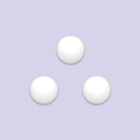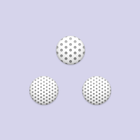❯ Looking for aminated silica? Click here.
Silica is a versatile coating that has wide applicability for many applications. nanoComposix’s ability to manipulate the properties of the silica shells enables the engineering of very sophisticated structures and is considered one of our core competencies. Silica coatings are an amorphous network of silicon and oxygen that encapsulate the particle with a coating that can be many nanometers thick. The silica is added to the particle surface via the base catalyzed condensation of various silanes, usually alkoxyl silanes such as tetraethylethoxysilane (TEOS). This is known as Stöber growth. Through the selection of various silanes, different chemical functionality can be integrated within and on the surface of the silica coating.

In addition, the porosity of the silica surface can be modified by the addition of various templating molecules which can subsequently be removed, giving rise to pores. For instance, mesoporous silica shells can be formed by templating off surfactants such as cetyltrimethylammonium bromide (CTAB).
Silica shelled particles have good salt stability and are one of the best coatings to preserve the optical properties of metal nanoparticles when integrated into composites and coatings, acting as an insulating steric layer that prevents the surface plasmons of particles from interacting with other particles even when the particles themselves may be in physical contact.
Through the incorporation of other silanes, the silica surface can be rendered hydrophobic. It is important to note that the silica on the surface of the particles grown by Stöber growth may be quite labile and can dissolve away to silicic acid species. The incomplete hydrolysis of the silane precursors may encourage this dissolution. While this may only cause the loss of some surface layers, if these layers contain the functional groups of interest the particles may lose their properties. For applications where stability of the silica shell in aqueous solutions is important, we strongly recommend using aluminosilicate shells instead of silica. Any silica shell can be transformed into an aluminosilicate shell via a proprietary solution-based method (nanoComposix patent US 9,675,953).
Advantages
- Dispersive in a wide range of solvents with a high degree of stability
- Retain optical properties of the core metal nanoparticles when integrated into composites and coatings
- Can be dried down and redispersed without agglomeration
- Allows particle surfaces to be modified with exquisite control and a wide range of functionality
- Allows engineering of controlled aggregates
Representative Source: tetraethyl orthosilicate (Sigma Aldrich, 333859)
Property Highlights
- Not Displaceable: strongly bound to the particle surface
- Negatively Charged
- Isoelectric Point: ~3
- Compatible with polar solvents
Applications
- Biodiagnostic and nanomedicine applications
- Photothermal applications
- Color applications
- Controlled aggregation
Surface Charge

See above for a representative zeta potential-pH, or Isoelectric Point (IEP) curve for silica-shelled 40 nm gold nanoparticles. These data were generated by manual titration using HCl and NaOH and subsequent zeta potential measurement.
- Note: SiO2 nanoparticles have similar IEP behavior to the silica coated gold particles represented in the data above.
Silica shelled nanoparticles have low IEP’s, which means that they remain negatively charged at all but the most acidic of pH ranges (< 3). The magnitude of the negative charge steadily increases as the pH becomes more basic until around pH 10, when it starts to become more neutral likely due to electrical double layer suppression from high ionic content.
- We have demonstrated that for 40 nm gold and silver bPEI and citrate capped particles, the IEP curves are very similar. This should enable a reasonable basis for comparison of zeta potential for silver nanoparticles with the above data based on gold nanoparticles.
- For more information about zeta potential and IEP theory, click here.
Salt Stability

In the presence of a high enough salt concentration the surface charge of particles in solution can be shielded by the dissolved ions, leading to reduced colloidal stability. The ions in solution prevent the like charges from repelling one another as readily. For each particle type the salt concentration at which this colloidal destabilization occurs can be different.
The chart above provides the UV-vis spectrum of silica-shelled 40 nm nanoparticles in varying concentrations of sodium chloride (NaCl) solution.The samples were prepared by spiking separate solutions of nanoparticles with NaCl at the listed concentrations and allowing the resulting solution to incubate for 10 minutes prior to UV-Vis measurement.
If the nanoparticles are stable at the given salt concentration, we would expect the spectrum to remain the same as for the nanoparticles in pure water, with a strong optical plasmon absorbance at 520 nm. If the particles have begun to aggregate, we would expect this the be reflected in the spectrum with a decrease in the surface plasmon peak at 520 nm and an increase in absorbance at the longer wavelengths at which aggregates absorb (700–1100 nm).
Significant destabilization of the particles becomes apparent at 50 mM NaCl. At this concentration, a decrease in absorbance at 520 nm is observed, and a broad secondary peak at higher wavelengths arises due to the presence of aggregates.
Silver nanoparticles (of a given surface) can generally be expected to have lower salt stability than their gold counterparts.




